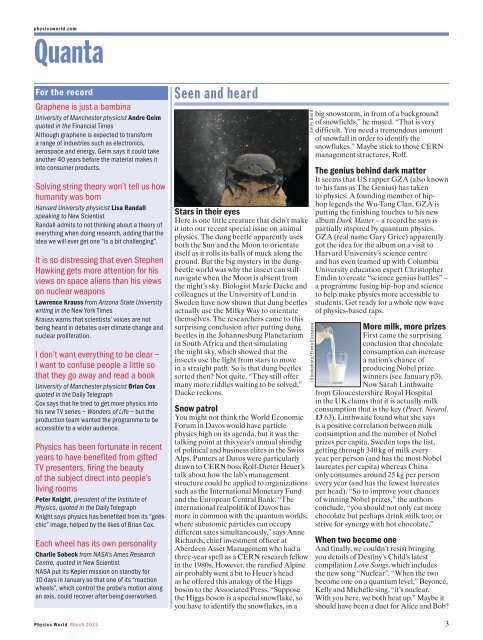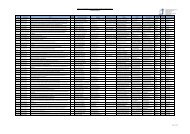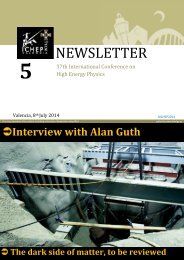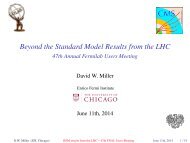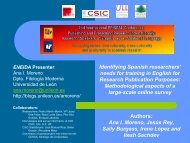PW_mar13_sample_issue
PW_mar13_sample_issue
PW_mar13_sample_issue
Create successful ePaper yourself
Turn your PDF publications into a flip-book with our unique Google optimized e-Paper software.
physicsworld.com<br />
Quanta<br />
For the record<br />
Graphene is just a bambina<br />
University of Manchester physicist Andre Geim<br />
quoted in the Financial Times<br />
Although graphene is expected to transform<br />
a range of industries such as electronics,<br />
aerospace and energy, Geim says it could take<br />
another 40 years before the material makes it<br />
into consumer products.<br />
Solving string theory won’t tell us how<br />
humanity was born<br />
Harvard University physicist Lisa Randall<br />
speaking to New Scientist<br />
Randall admits to not thinking about a theory of<br />
everything when doing research, adding that the<br />
idea we will ever get one “is a bit challenging”.<br />
It is so distressing that even Stephen<br />
Hawking gets more attention for his<br />
views on space aliens than his views<br />
on nuclear weapons<br />
Lawrence Krauss from Arizona State University<br />
writing in the New York Times<br />
Krauss warns that scientists’ voices are not<br />
being heard in debates over climate change and<br />
nuclear proliferation.<br />
I don’t want everything to be clear –<br />
I want to confuse people a little so<br />
that they go away and read a book<br />
University of Manchester physicist Brian Cox<br />
quoted in the Daily Telegraph<br />
Cox says that he tried to get more physics into<br />
his new TV series – Wonders of Life – but the<br />
production team wanted the programme to be<br />
accessible to a wider audience.<br />
Physics has been fortunate in recent<br />
years to have benefited from gifted<br />
TV presenters, firing the beauty<br />
of the subject direct into people’s<br />
living rooms<br />
Peter Knight, president of the Institute of<br />
Physics, quoted in the Daily Telegraph<br />
Knight says physics has benefited from its “geekchic”<br />
image, helped by the likes of Brian Cox.<br />
Each wheel has its own personality<br />
Charlie Sobeck from NASA’s Ames Research<br />
Centre, quoted in New Scientist<br />
NASA put its Kepler mission on standby for<br />
10 days in January so that one of its “reaction<br />
wheels”, which control the probe’s motion along<br />
an axis, could recover after being overworked.<br />
Seen and heard<br />
Stars in their eyes<br />
Here is one little creature that didn’t make<br />
it into our recent special <strong>issue</strong> on animal<br />
physics. The dung beetle apparently uses<br />
both the Sun and the Moon to orientate<br />
itself as it rolls its balls of muck along the<br />
ground. But the big mystery in the dungbeetle<br />
world was why the insect can still<br />
navigate when the Moon is absent from<br />
the night’s sky. Biologist Marie Dacke and<br />
colleagues at the University of Lund in<br />
Sweden have now shown that dung beetles<br />
actually use the Milky Way to orientate<br />
themselves. The researchers came to this<br />
surprising conclusion after putting dung<br />
beetles in the Johannesburg Planetarium<br />
in South Africa and then simulating<br />
the night sky, which showed that the<br />
insects use the light from stars to move<br />
in a straight path. So is that dung beetles<br />
sorted then? Not quite. “They still offer<br />
many more riddles waiting to be solved,”<br />
Dacke reckons.<br />
Snow patrol<br />
You might not think the World Economic<br />
Forum in Davos would have particle<br />
physics high on its agenda, but it was the<br />
talking point at this year’s annual shindig<br />
of political and business elites in the Swiss<br />
Alps. Punters at Davos were particularly<br />
drawn to CERN boss Rolf-Dieter Heuer’s<br />
talk about how the lab’s management<br />
structure could be applied to organizations<br />
such as the International Monetary Fund<br />
and the European Central Bank. “The<br />
international realpolitik of Davos has<br />
more in common with the quantum worlds,<br />
where subatomic particles can occupy<br />
different sates simultaneously,” says Anne<br />
Richards, chief investment officer at<br />
Aberdeen Asset Management who had a<br />
three-year spell as a CERN research fellow<br />
in the 1980s. However, the rarefied Alpine<br />
air probably went a bit to Heuer’s head<br />
as he offered this analogy of the Higgs<br />
boson to the Associated Press. “Suppose<br />
the Higgs boson is a special snowflake, so<br />
you have to identify the snowflakes, in a<br />
big snowstorm, in front of a background<br />
of snowfields,” he mused. “That is very<br />
difficult. You need a tremendous amount<br />
of snowfall in order to identify the<br />
snowflakes.” Maybe stick to those CERN<br />
management structures, Rolf.<br />
The genius behind dark matter<br />
It seems that US rapper GZA (also known<br />
to his fans as The Genius) has taken<br />
to physics. A founding member of hiphop<br />
legends the Wu-Tang Clan, GZA is<br />
putting the finishing touches to his new<br />
album Dark Matter – a record he says is<br />
partially inspired by quantum physics.<br />
GZA (real name Gary Grice) apparently<br />
got the idea for the album on a visit to<br />
Harvard University’s science centre<br />
and has even teamed up with Columbia<br />
University education expert Christopher<br />
Emdin to create “science genius battles” –<br />
a programme fusing hip-hop and science<br />
to help make physics more accessible to<br />
students. Get ready for a whole new wave<br />
of physics-based raps.<br />
More milk, more prizes<br />
First came the surprising<br />
conclusion that chocolate<br />
consumption can increase<br />
a nation’s chance of<br />
producing Nobel prize<br />
winners (see January p3).<br />
Now Sarah Linthwaite<br />
from Gloucestershire Royal Hospital<br />
in the UK claims that it is actually milk<br />
consumption that is the key (Pract. Neurol.<br />
13 63). Linthwaite found what she says<br />
is a positive correlation between milk<br />
consumption and the number of Nobel<br />
prizes per capita. Sweden tops the list,<br />
getting through 340 kg of milk every<br />
year per person (and has the most Nobel<br />
laureates per capita) whereas China<br />
only consumes around 25 kg per person<br />
every year (and has the fewest laureates<br />
per head). “So to improve your chances<br />
of winning Nobel prizes,” the authors<br />
conclude, “you should not only eat more<br />
chocolate but perhaps drink milk too; or<br />
strive for synergy with hot chocolate.”<br />
When two become one<br />
And finally, we couldn’t resist bringing<br />
you details of Destiny’s Child’s latest<br />
compilation Love Songs, which includes<br />
the new song “Nuclear”. “When the two<br />
become one on a quantum level,” Beyoncé,<br />
Kelly and Michelle sing, “it’s nuclear.<br />
With you here, we both heat up.” Maybe it<br />
should have been a duet for Alice and Bob?<br />
Physics World March 2013 3<br />
Emily Baird<br />
iStockphoto/Elena Elisseeva


